Asian shares and US stock futures tumbled on Friday as the number of coronavirus cases continued to rise.
Disruptions to business worsened and worries deepened over the long-term damage to the global economy.
The total number of cases worldwide has surpassed 98,000 with more than 3,300 deaths. The epidemic has forced many cities and countries to suspend industrial operations and implement travel restrictions, while companies have also stepped up efforts to contain the spread. HSBC sent home more than 100 staff in London on Thursday after a worker tested positive for the virus.
The S&P 500 fell 3.39 per cent. The index has skidded more than 10 per cent from its February 19 closing high, and last week saw its biggest weekly percentage decline since October 2008. The Dow was down 3.58 per cent and the Nasdaq 3.10 per cent.
The drop continued in Asia in morning trading on Friday. Japan’s Nikkei stock index closed down 2.72 per cent lower on Friday, a six-month low. Shares in China fell 1.22 per cent, while stocks in Hong Kong fell 2.12 per cent.
US stock futures erased early gains to trade down 1.21 per cent.
Yields on 10-year US Treasuries fell to a record low of 0.81 per cent on Friday. The two-year yield skidded to 0.4810 per cent, the lowest since April 2015.
Treasury futures jumped as investors increased bets that the Federal Reserve will follow this week's surprise 50 basis point rate cut with further easing to prevent corporate bond spreads from widening further.
“Given the pace of US inflation, yields are too low and I certainly don't want to buy Treasuries at this level," Ayako Sera, market strategist at Sumitomo Mitsui Trust Bank in Tokyo, told Reuters. "But the fact that other people are buying shows very strong desire to escape from risk. This is a panic."
Oil prices also fell due to worries that non-Opec oil producers might not agree to proposed output cuts. Brent closed below $50 on Thursday for the first time since mid-2017.
Brent for May settlement fell 50 cents, or 1 per cent, to $49.49 a barrel on the ICE Futures Europe exchange as of 7:33am in London (11:33am UAE time) after rising as much as 0.9 per cent earlier. The contract dropped 2.2 per cent to settle at $49.99 on Thursday and is down 2 per cent for the week.
West Texas Intermediate futures for April delivery lost 46 cents, or 1 per cent, to $45.44 a barrel on the New York Mercantile Exchange. The US crude benchmark ended 1.9 per cent lower on Thursday and is up 1.5 per cent this week.
Opec on Thursday pushed for crude output by the group and associated producers — a group known as Opec+ — to be cut by an extra 1.5 million barrels per day until the end of 2020. The call came ahead of an Opec+ meeting scheduled for Friday in Vienna.
“No investor is willing to play Russian roulette in such a moody market environment, especially given that the chances of Russia vetoing further cuts are relatively high,” said Ipek Ozkardeskaya, a senior analyst at Swissquote Bank.
If Russia does veto further cuts, the price of a barrel could “sink towards the $40 level”, but if Russia agrees, the Opec+ action could send “WTI rallying towards $50 per barrel”, Ms Ozkardeskaya said.
A hit to oil demand has already seen prices slump around 23 per cent so far this year. International Energy Agency chief Faith Birol told a Congressional hearing in Washington on Thursday that the IEA plans to revise down its oil-demand forecasts next week due to the impact of the spreading coronavirus, specifically in the transport sector.


